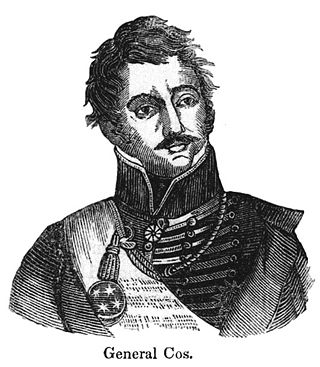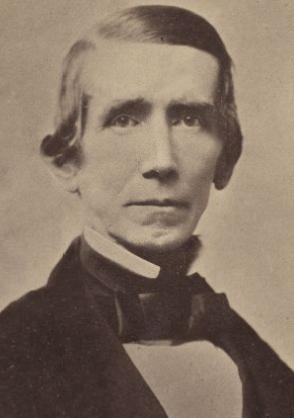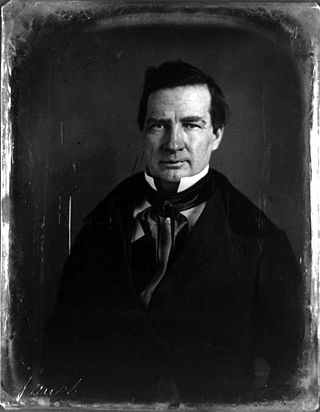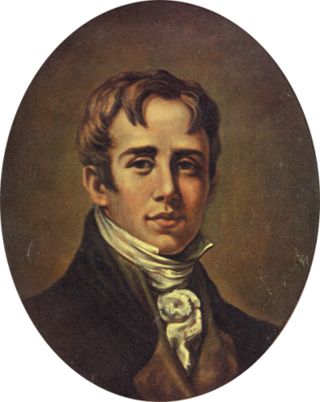
The 1830s was a decade of the Gregorian calendar that began on January 1, 1830, and ended on December 31, 1839.

1836 (MDCCCXXXVI) was a leap year starting on Friday of the Gregorian calendar and a leap year starting on Wednesday of the Julian calendar, the 1836th year of the Common Era (CE) and Anno Domini (AD) designations, the 836th year of the 2nd millennium, the 36th year of the 19th century, and the 7th year of the 1830s decade. As of the start of 1836, the Gregorian calendar was 12 days ahead of the Julian calendar, which remained in localized use until 1923.

The Texas Revolution was a rebellion of colonists from the United States and Tejanos against the centralist government of Mexico in the Mexican state of Coahuila y Tejas. Although the uprising was part of a larger one, the Mexican Federalist War, that included other provinces opposed to the regime of President Antonio López de Santa Anna, the Mexican government believed the United States had instigated the Texas insurrection with the goal of annexation. The Mexican Congress passed the Tornel Decree, declaring that any foreigners fighting against Mexican troops "will be deemed pirates and dealt with as such, being citizens of no nation presently at war with the Republic and fighting under no recognized flag". Only the province of Texas succeeded in breaking with Mexico, establishing the Republic of Texas. It was eventually annexed by the United States.

Samuel Houston was an American general and statesman who played a prominent role in the Texas Revolution. He served as the first and third president of the Republic of Texas and was one of the first two individuals to represent Texas in the United States Senate. He also served as the sixth governor of Tennessee and the seventh governor of Texas, the only individual to be elected governor of two different states in the United States.

Martín Perfecto de Cos was a Mexican Army general and politician during the mid-19th century. Born in Veracruz, the son of an attorney, he became an army cadet at the age of 20, a Lieutenant in 1821, and a Brigadier General in 1833.

The Battle of San Jacinto, fought on April 21, 1836, in present-day La Porte and Deer Park, Texas, was the final and decisive battle of the Texas Revolution. Led by General Samuel Houston, the Texan Army engaged and defeated General Antonio López de Santa Anna's Mexican army in a fight that lasted just 18 minutes. A detailed, first-hand account of the battle was written by General Houston from the headquarters of the Texan Army in San Jacinto on April 25, 1836. Numerous secondary analyses and interpretations have followed.

The flag of Texas is the official flag of the U.S. state of Texas. It is well known for its prominent single white star which gives the flag its commonly-used name: "Lone Star Flag". This lone star, in turn, gives rise to the state's nickname: "The Lone Star State". The flag, flown at homes and businesses statewide, is highly popular among Texans and is treated with a great degree of reverence and esteem within Texas. Along with the flag of Hawaii, it is one of two state flags to have previously served as a national flag of an independent country. In 2001, the North American Vexillological Association surveyed its members on the designs of the 72 U.S. state, territorial, and Canadian provincial flags and ranked the Texas flag second, behind New Mexico.

David Gouverneur Burnet was an early politician within the Republic of Texas, serving as the interim president of Texas in 1836, the second vice president of the Republic of Texas (1839–1841), and the secretary of State (1846) for the new state of Texas after it was annexed to the United States.

James Pinckney Henderson was an American and Republic of Texas lawyer, politician, and soldier, and the first governor of the State of Texas.

Thomas Jefferson Rusk was an early political and military leader of the Republic of Texas, serving as its first Secretary of War as well as a general at the Battle of San Jacinto. He was later a US politician and served as a Senator from Texas from 1846 until his suicide. He served as the President pro tempore of the United States Senate in 1857.

James Butler Bonham was a 19th-century American soldier who died at the Battle of the Alamo during the Texas Revolution. He was a second cousin of William B. Travis and was a messenger of the Battle of the Alamo. His younger brother, Milledge Luke Bonham, was a brigadier general in the Confederate States Army in the American Civil War, and served as Governor of South Carolina from 1862 to 1864.
The battle of Agua Dulce Creek was a skirmish during the Texas Revolution between Mexican troops and rebellious colonists of the Mexican province of Texas, known as Texians. As part of the Goliad Campaign to retake the Texas Gulf Coast, Mexican troops ambushed a group of Texians on March 2, 1836. The skirmish began approximately 26 miles (42 km) south of San Patricio, in territory belonging to the Mexican state of Tamaulipas.
The Consultation, also known as the Texian Government, served as the provisional government of Mexican Texas from October 1835 to March 1836 during the Texas Revolution. Tensions rose in Texas during early 1835 as throughout Mexico federalists began to oppose the increasingly centralist policies of the government. In the summer, Texians elected delegates to a political convention to be held in Gonzales in mid-October. Weeks before the convention and war began, the Texian Militia took up arms against Mexican soldiers at the Battle of Gonzales. The convention was postponed until November 1 after many of the delegates joined the newly organized volunteer Texian Army to initiate a siege of the Mexican garrison at San Antonio de Bexar. On November 3, a quorum was reached in San Antonio. Within days, the delegates passed a resolution to define why Texians were fighting. They expressed allegiance to the deposed Constitution of 1824 and maintained their right to form the General Council. In the next weeks, the council authorized the creation of a new regular army to be commanded by Sam Houston. As Houston worked to establish an army independent from the existing volunteer army, the council repeatedly interfered in military matters.

The Grand Lodge of Texas, Ancient Free and Accepted Masons is the largest of several governing bodies of Freemasonry in the State of Texas, being solely of the Ancients' tradition and descending from the Ancient Grand Lodge of England, founded on 17 June 1751 at the Turk's Head Tavern, Greek Street, Soho, London. According to historian James D. Carter, the "Grand Lodge of the Republic of Texas, A.F. & A.M." was founded on 16 April 1838. However, its first Grand Master and other grand officers were installed by Sam Houston on 11 May 1838. The Grand Lodge of Texas is one of the largest in the world, reporting 69,099 members in 2019. The current Grand Lodge of Texas facilities were made possible by the fundraising efforts of Waco Masonic Lodge No. 92.
The Texan schooner Independence was one of the four schooners of the First Texas Navy (1836–1838). At the direction of Texas Governor Henry Smith, in 1836 Charles Hawkins took command of United States revenue cutter Ingham acquired by the Texas Navy and renamed Independence.

The Texian Army, also known as the Revolutionary Army and Army of the People, was the land warfare branch of the Texian armed forces during the Texas Revolution. It spontaneously formed from the Texian Militia in October 1835 following the Battle of Gonzales. Along with the Texian Navy, it helped the Republic of Texas win independence from the Centralist Republic of Mexico on May 14, 1836 at the Treaties of Velasco. Although the Texas Army was officially established by the Consultation of the Republic of Texas on November 13, 1835, it did not replace the Texian Army until after the Battle of San Jacinto.

The Presidio Nuestra Señora de Loreto de la Bahía, known more commonly as Presidio La Bahía, or simply La Bahía is a fort constructed by the Spanish Army that became the nucleus of the modern-day city of Goliad, Texas, United States. The current location dates to 1747.
Philip Dimmitt (1801–1841) was an officer in the Texian Army during the Texas Revolution. Born in Kentucky, Dimmitt moved to Texas in 1823 and soon operated a series of trading posts. After learning that Mexican General Martín Perfecto de Cos was en route to Texas in 1835 to quell the unrest, Dimmitt proposed that the general be kidnapped on his arrival at Copano. The plan was shelved when fighting broke out at Gonzales, but by early October, 1835, it had been resuscitated by a group of volunteers at Matamoros. Not knowing that Cos had already departed for San Antonio de Bexar, this group decided to corner Cos at Presidio La Bahia in Goliad. Dimmitt joined them en route, and participated in the battle of Goliad.

Events in the year 1836 in Mexico.

The Twin Sisters are a pair of cannons used by Texas Military Forces during the Texas Revolution. They are among the most famous artillery in Texas military history with the "Come and Take It" cannon starting the revolution at the Battle of Gonzales and the Twin Sisters winning it at the Battle of San Jacinto. The Twin Sisters were also potentially used during the Mexican Invasions of 1842 and American Civil War.


















